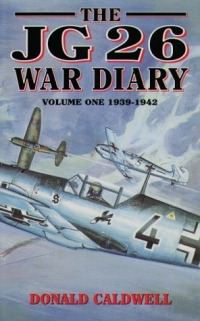|
The JG 26 War Diary: 1939-1942 by Donald Caldwell
Review by Bernard Dy |
||||
|
Donald Caldwell's JG 26 War Diary 1939-1942 isn't your average war book, or your average history book. It is, as its title succinctly states, a diary of the famed Luftwaffe squadron through the first half of WWII. In a great effort, author Caldwell culls data from interviews, numerous books, German and English war records, and individual diaries of Jagdgeschwader 26 (JG 26) crewmembers into one volume. You might expect such a tome to brim with amazing anecdotes of hair-raising dogfights and bawdy excursions in the French countryside. In that respect, you may be disappointed, for this diary doesn't tell all. It's a scholarly manual bound with the seemingly altruistic motives of Caldwell to compile the statistics of the Abbeville Boys for other historians. Narrated in a cool but professional tone, the JG 26 War Diary delivers an almost daily overview of JG26 from March 1939, to December, 1942. The approach is clinical and direct, and leaves little room for human ambiance. After a brief text description of a given day's events, a chart summarizes the JG26 kills and casualties, listing pilot, type of aircraft downed, time and location of conflict, and whether the score is confirmed. Exploits beyond combat engagements are rarely detailed except when the events have military value. The entire text is consistent with this format, and is capped by a sizable index and bibliography. It should be quite clear that readers expecting a biographical history similar to those written by Pappy Boyington or Randy Cunningham, or perhaps a tale from Tom Clancy or Stephen Coonts, should look elsewhere. That point made, those interested in JG 26 must read this text. It may not inspire guffaws or tears, but it does present an accurate picture of the squadron's role in the Luftwaffe's early success. The pages of the victory charts show repeatedly, to the point of litany, that the "Abbeville Boys" thoroughly outperformed their English adversaries. In addition, where the book may lack emotion, it more than compensates with abundant photos of the planes and pilots. The black and white captures of the famous Adolf Galland don't surprise, but also here are more than a hundred previously unpublished shots of other JG 26 crew and craft. Of particular interest are the photos of Hitler's car, seen leaving JG 26 after a 1940 Christmas dinner with the troops in Abbeville. The photo captions are often fascinating, pointing out details such as a noteworthy unit insignia or method of kill markings on a plane. The book also contains maps of the European and Mediterranean theaters JG 26 fought in, though they're lacking in detail. The inclusion of smaller context related detail maps would have better illustrated the squadron's movements. Caldwell does an admirable job of avoiding the regurgitation of material easily found in other works, noting the proliferation of such works as Galland's biographies or general Luftwaffe texts. He cannot resist the more delicious quotes, however, and includes reference to this famous Galland recollection: "For more than forty minutes outside his train Göring blamed Mölders and myself for the bombers' high losses. When he asked us what he could do to improve the capability of our units, Mölders wanted his Geschwader equipped with the DB 601N engine, while I said I wanted mine equipped with Spitfires." |
 Other areas where Caldwell strays from standard narration of a day's events are short forays to describe Luftwaffe tactics or critical events that changed them. He also provides an interesting insight to the challenge of interpreting victory claims, revealing the tendencies of the British to overrate their performance and noting the poor aircraft identification skills of the Germans. Most importantly, Caldwell describes the unseen side of JG 26, naming all the squad members. While many may know the name of Adolf Galland, there are dozens of his squadron mates that performed admirably, including two that were Galland's brothers. Exacting narrations of dogfights are rare, though Caldwell illustrates a few when he has details. Although this generally dry book caters to historians and JG 26 enthusiasts, there are select passages flight simulation readers can identify with and enjoy. Below is an excerpt, describing Oberleutnant Joachim Müncheberg's combat strategy, when he and a segment of JG 26 participated in the Mediterranean Theater in 1941. It shows that what some gamers disparagingly call "boom and zoom" tactics are natural and commonplace in aerial combat. "Müncheberg's well-disciplined pilots were under strict orders not to accept battle on the RAF's terms. If they could not begin combat with a height advantage, they simply refused battle. The Bf 109E-7 was so much faster than the Hurricane I - in climbing, diving, or level flight - that the Luftwaffe fighters could maintain the initiative under any circumstances, as long as they avoided long turning engagements. Müncheberg's fighters, typically in a strength of one or two Schwärme, took off from Gela, climbed steadily on the short approach to Malta until they were well above 20,000 feet, dove on any appropriate targets, zoomed up after a quick attack, and climbed back to safety." This is a valuable and competent compilation of data for any WWII aviation historian. General audiences may not find it interesting enough, but the aviation enthusiast will appreciate its straightforward approach and candor. The JG 26 War Diary, 1939-1942 is published by Grub Street, ISBN 1 898697 52-3 See also our Military History Index and our Book and Movie Reviews. Join a discussion forum on this article by clicking HERE.
|
|||
|
Copyright © 1997 - 2000 COMBATSIM.COM, INC. All Rights Reserved. Last Updated October 28th, 1999 |
||||
